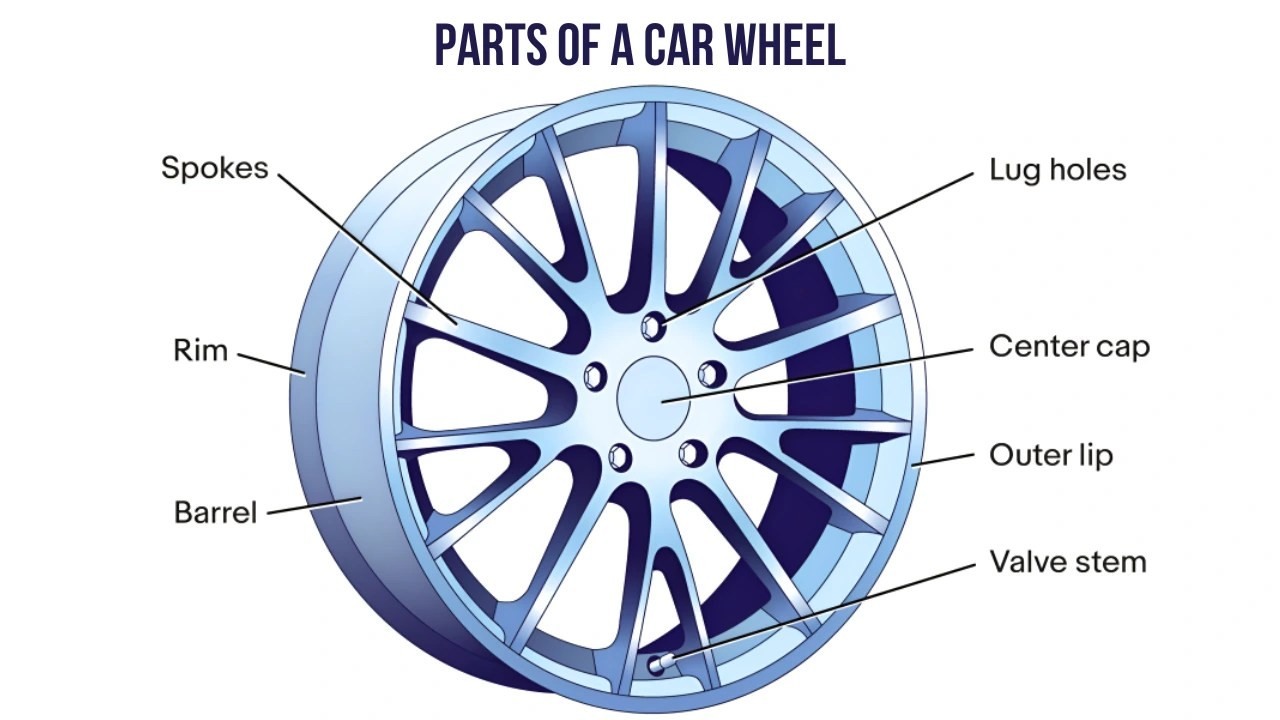Wheels are fundamental to every vehicle, from high-performance sports cars to everyday family sedans. They are more than just round objects that allow us to move; they are complex assemblies of parts working in harmony. To truly understand your vehicle and ensure its optimal performance and safety, knowing the anatomy of a car wheel is crucial. This article will serve as your comprehensive guide to the Car Tire Parts Diagram, detailing each component and its function.
 Parts of A Car Wheel Diagram
Parts of A Car Wheel Diagram
Alt text: Detailed car tire parts diagram illustrating and labeling each component of a wheel assembly for easy identification.
Let’s break down the essential components that make up a car wheel, often referred to as the wheel assembly, which includes the tire and the wheel itself.
Key Components of a Car Wheel Assembly
A car wheel is not just a single piece; it’s a system composed of various parts, each playing a vital role. We can categorize the main parts into the tire, the rim, and associated hardware.
1. The Tire: The Vehicle’s Contact Point with the Road
The tire is arguably the most recognized part of the wheel. It’s the flexible, rubber component that encircles the rim and provides the crucial contact between the vehicle and the road surface. Modern tires are pneumatic, meaning they are filled with air, which provides cushioning for a smoother ride and allows the tire to conform to road irregularities.
Beyond comfort, tires are critical for safety. They are engineered with tread patterns designed to grip the road in diverse conditions – rain, snow, and even ice – maximizing traction for acceleration, braking, and cornering. Choosing the right type of tire, appropriate for your vehicle and driving conditions, is paramount for safety and performance.
2. The Rim: The Wheel’s Structural Foundation
If the tire is the skin, then the rim is the skeleton of the wheel assembly. The rim is the metal structure that the tire is mounted onto. It provides the tire with its shape and the necessary support to hold air and withstand the stresses of driving. Rims are typically manufactured from steel or aluminum alloys, chosen for their strength and durability.
Rim designs are diverse, ranging from simple, functional steel rims to aesthetically driven alloy wheels with intricate spoke patterns and polished finishes. For trucks and heavy-duty vehicles, rims are built to be more robust to handle heavier loads, often prioritizing function over purely decorative aspects. The dimensions of the rim, including its diameter and width, dictate the compatible tire sizes.
3. The Hub: Connecting the Wheel to the Vehicle
The hub is the central part of the wheel assembly that facilitates the connection to the vehicle’s axle. It is the crucial interface where the wheel is mounted, and it often houses vital braking components like brake rotors, calipers, and pads. The hub allows the wheel to rotate freely while being securely attached to the vehicle, enabling movement and controlled stopping.
Extending from the hub are wheel studs or bolts. These are threaded fasteners that protrude outwards and are used to secure the wheel to the hub using lug nuts or wheel bolts. The hub is the mechanical heart of the wheel assembly, ensuring it functions as an integral part of the vehicle’s drivetrain and braking system.
4. Spokes: Structural and Aesthetic Elements
Spokes are the structural elements that radiate outwards from the central hub and connect to the rim. They contribute significantly to the wheel’s structural integrity, distributing load and absorbing impacts. Beyond their functional role, spokes are a major design element in wheel aesthetics.
The design of spokes varies dramatically in number, shape, width, and pattern, contributing to the unique look of different wheels. While five-spoke wheels are common for their balanced structural properties, the number of spokes generally has a minimal impact on performance compared to factors like material and manufacturing processes. Ultimately, spoke design is often chosen for visual appeal, allowing for customization and personal style.
5. Outer Lip (Dish): Aesthetic Depth
The outer lip, or dish, is the area of the wheel that extends outwards from the spokes towards the edge of the rim. The depth of the dish is primarily an aesthetic consideration. Wheels with a significant distance between the spokes and the outer edge are often referred to as “deep-dish” wheels.
While deep-dish designs can enhance a vehicle’s appearance, especially in classic and custom car styles, a very deep dish can make the wheel face more vulnerable to damage from curb rash or impacts.
6. Barrel: Tire Mounting Structure
The barrel is the main cylindrical part of the rim that provides the structure for tire mounting. It features several key areas that are crucial for tire fitment and retention:
- Drop Center: This is the smallest diameter part of the barrel, strategically designed to allow for tire mounting and removal without excessively stretching the tire bead wires.
- Flanges: These are flared edges at the barrel’s edges that extend outwards. Flanges are essential for preventing the tire from slipping off the rim during driving.
- Beads: Located just inside the flanges are flat bead seat areas. These are the precise surfaces where the tire beads (the reinforced edges of the tire) sit and create an airtight seal against the rim.
- Mounting Humps: These are small ridges on the bead seat area that further secure the tire beads, preventing them from slipping inwards towards the drop center during cornering or underinflation.
7. Center Cap: Finishing and Protection
The center cap is a removable cover that fits over the center bore of the wheel on the outboard side. It serves both aesthetic and protective purposes. Center caps often feature manufacturer logos or branding and conceal the wheel hub components from dirt and debris. In many modern vehicles, the center cap also covers and protects the lug nuts from corrosion and damage.
8. Valve Stem: Inflation and Pressure Monitoring
The valve stem is a small, typically metal, fitting that protrudes through a hole in the rim. It is equipped with an air valve that allows for tire inflation and deflation. Valve stems are critical for maintaining proper tire pressure, which is essential for safety, fuel efficiency, and tire longevity. Modern vehicles increasingly incorporate TPMS (Tire Pressure Monitoring System) sensors into the valve stem to provide real-time tire pressure readings to the driver.
9. Additional Wheel Hardware
Beyond the main components, several smaller parts are essential to the wheel assembly:
- Lug Nuts/Wheel Bolts: These fasteners (nuts or bolts) are used to secure the wheel to the wheel studs or directly to the hub.
- Wheel Studs: Threaded studs permanently mounted to the hub that lug nuts thread onto.
- Wheel Bearings: Located within the hub, wheel bearings allow for smooth rotation of the wheel around the axle.
- Wheel Seal: Seals that prevent contaminants from entering the wheel bearings and grease from escaping.
- Wheel Spacers: Used in some applications to adjust wheel offset, changing the wheel’s position relative to the vehicle’s body.
- Wheel Locks: Security devices that replace one lug nut per wheel to deter wheel theft.
- Wheel Balancing Weights: Small weights attached to the rim to balance the wheel and tire assembly, minimizing vibrations at higher speeds.
- Wheel Valve Cap: A small cap that screws onto the valve stem to protect the valve core from dirt and moisture.
- Dust Cap: A cap that covers the outer end of the wheel hub to protect bearings from dust and debris.
- Rim Flange: The flared edge of the rim barrel that helps retain the tire.
- Bead: The reinforced edge of the tire that seats against the rim.
Understanding the car tire parts diagram and the function of each component is invaluable for vehicle maintenance, troubleshooting, and making informed decisions about tire and wheel replacements or upgrades. This knowledge empowers you to communicate effectively with mechanics, ensure your vehicle’s safety, and optimize its performance on the road.
